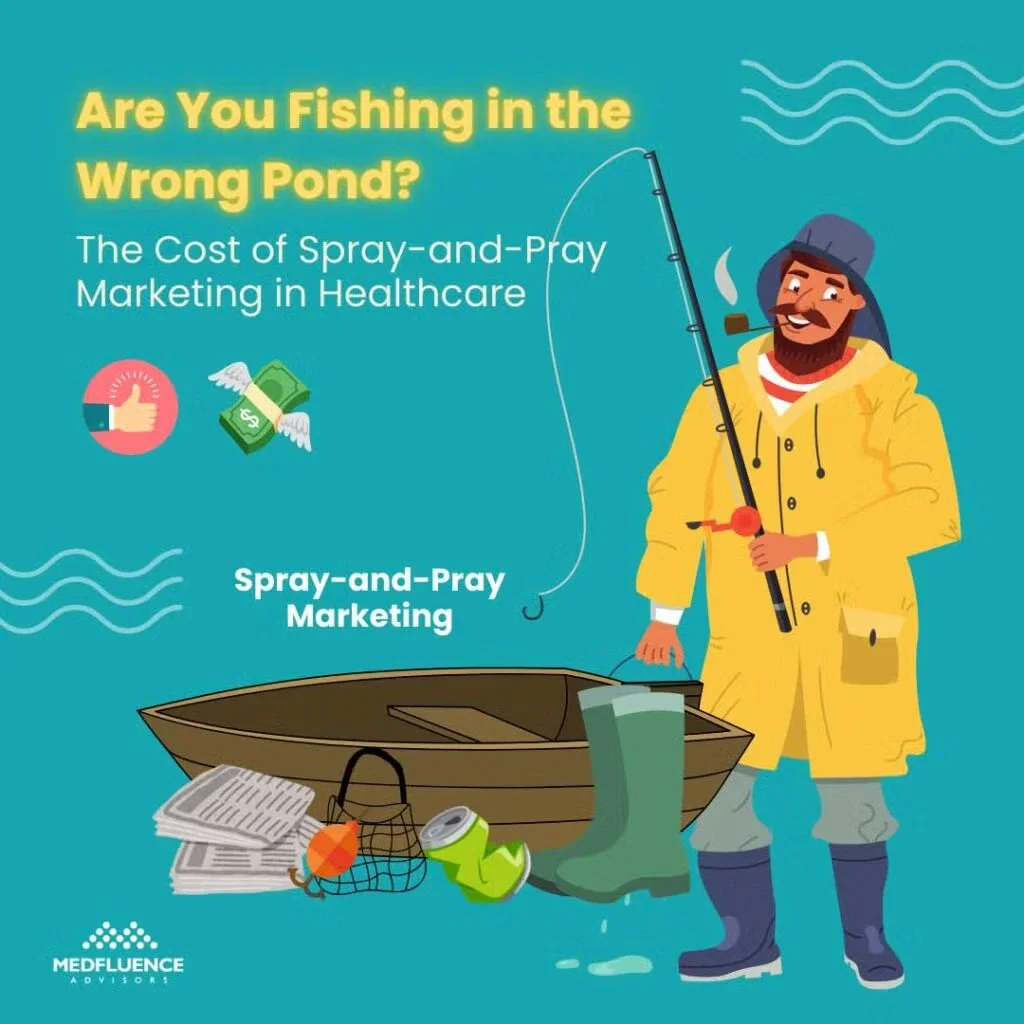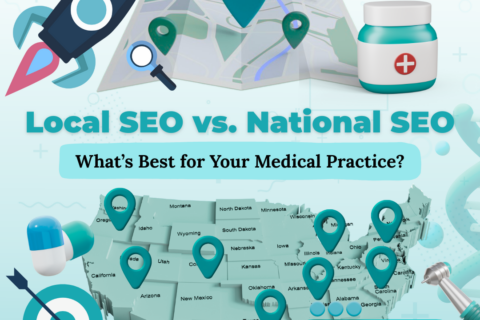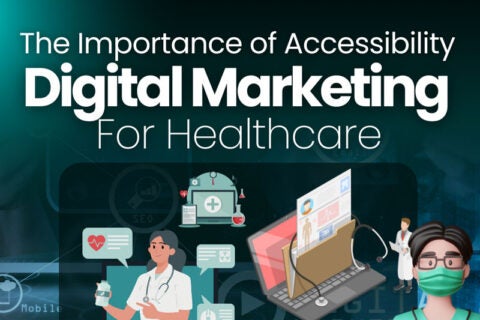The Worst Way to Do Marketing

Picture a frustrated doctor standing at their office window, watching potential patients walk by. They’ve tried everything – Facebook ads, radio spots, email campaigns, even those expensive billboard ads on the highway. Yet their waiting room still isn’t as busy as they’d hoped. Sound familiar?
Running a private practice is hard enough without throwing money at marketing strategies that don’t work. It’s like fishing with a giant net in the wrong pond – sure, you might catch something, but probably not the fish you’re actually looking for.
Let’s talk about that “spray-and-pray” approach to marketing. You know the one – where practices toss their message everywhere possible, cross their fingers, and hope something sticks. It’s tempting, right? After all, more exposure must mean more patients… except when it doesn’t.
Here’s the good news: There’s a better way to market a medical practice. One that doesn’t involve throwing money at every shiny advertising opportunity that comes along. Want to know how to find your ideal patients and speak directly to them – without emptying your bank account in the process? Keep reading to learn strategies that you can start using tomorrow.
What is the “Spray-and-Pray” Method?
Remember that time you lost your keys and frantically searched every room in the house? That panicked “it must be somewhere” feeling is exactly what drives many medical practices to spray-and-pray marketing. They throw their message everywhere – social media, radio, newspapers, billboards, email blasts – hoping something, anything, will work.
It’s easy to see why this shotgun approach is so tempting. When patient numbers are down and the pressure is on, it feels productive to be “doing everything.” Plus, there’s that voice in the back of your head saying, “The more people who see us, the better, right?”
Picture a new practice owner, Dr. Sarah, who just took over a family clinic. Her first marketing move? Buying every advertising spot she could afford – from local magazine ads to sponsored posts on every social platform imaginable. “If I’m everywhere,” she thought, “patients will come.” Three months and $20,000 later, she had exactly three new patients to show for it.
Here’s what makes this approach so alluring: it plays into our natural “more is more” instinct. It feels safer to spread your bets around rather than going all-in on a few carefully chosen strategies. After all, if you advertise everywhere, you can’t miss your target audience… Can you?
Spoiler alert: You absolutely can. And most practices do.
But before we talk about why this approach fails (and what to do instead), let’s be honest – we’ve all been there. Whether it’s panic-buying advertising spots or saying yes to every marketing opportunity that comes along, the spray-and-pray method is like comfort food for worried practice owners. It feels good in the moment, but you’re usually left regretting it later.
The Costs of Spray-and-Pray Marketing
Think of it this way: Imagine throwing handfuls of business cards into a crowded stadium. Sure, you might hit thousands of people, but how many of them are actually looking for a healthcare provider? How many live within 20 minutes of your practice? How many have the insurance you accept? Suddenly, those thousands of “contacts” don’t look so impressive.
The hidden costs pile up too:
- Staff time wasted managing multiple ineffective campaigns
- Missed opportunities to build deeper connections with your ideal patients
- Brand confusion when your message isn’t consistent across channels
- The emotional toll of seeing minimal results despite maximum effort
One private practice we know spent six months “trying everything” – from Instagram ads to local radio spots. Their cost per new patient acquisition? A whopping $892. Meanwhile, their competitor across town focused solely on targeted Facebook ads and email marketing to local parent groups. Their cost per new patient? Just $127.
Here’s another way to look at it: If you’re spending $5,000 a month on marketing, would you rather have:
- A billboard seen by 100,000 random drivers
- OR focused ads reaching 10,000 people actually looking for your services?
The numbers tell the story: Practices using the spray-and-pray method typically see engagement rates below 1%, while targeted campaigns often hit 15-20% or higher. That’s the difference between shouting into the void and having a conversation with interested patients.

Why “Reaching Everyone” Is a Myth
Let’s do some quick math that might surprise you. In a city of 500,000 people, how many are actually potential patients for your practice? Let’s break it down:
First, consider these natural filters:
- Geographic reach (most patients won’t drive more than 20 minutes)
- Insurance acceptance (you likely work with specific providers)
- Age and demographic needs (pediatricians need families, orthopedists need active adults)
- Current need for your services (not everyone needs specialized care right now)
When you run the numbers, that city of 500,000 suddenly shrinks to maybe 25,000 realistic potential patients. Now here’s where it gets interesting: spending $10,000 on broad marketing means you’re paying to reach 475,000 people who will never become your patients.
Understanding this principle is crucial because it shapes everything about your marketing strategy:
- How you allocate your budget
- Where you place your ads
- What message you craft
- Which metrics actually matter
Ready to learn how to identify and reach your real audience? Head on to the next section.
Targeting the Right Audience: A Better Approach
Let’s start with a question that too few practices ask: Who are your perfect patients? Not just “anyone with a pulse and insurance,” but the people who genuinely need your services, value your approach, and are most likely to become loyal, long-term patients.
Getting to Know Your Ideal Patients
Think of this like creating a character in a story. Your ideal patient isn’t just a collection of demographics – they’re a real person with specific:
- Health concerns and goals
- Daily routines and habits
- Fears and frustrations about healthcare
- Communication preferences
- Decision-making factors
For example, a physical therapy practice might discover their most successful patients are:
- Active adults aged 35-55
- Living within 15 minutes of the clinic
- Dealing with sports injuries or chronic pain
- Motivated to avoid surgery
- Research-oriented and prefer detailed explanations
- Value early morning or late evening appointments
- Often find the practice through sports club recommendations
Finding Your Patient Profile Gold Mine
The best part? You’re sitting on a treasure trove of information about your ideal patients. Here’s how to mine that gold:
-
Analyze Your Current Stars
-
-
- Look at your top 20 patients (those who return, refer others, and actively engage in treatment)
- What do they have in common?
- How did they find you?
- What made them choose your practice?
-
-
Use Your Data Tools
-
-
- Check your appointment scheduling system for patterns
- Review Google Analytics to see who’s visiting your website
- Monitor social media insights to understand who engages with your content
- Track which insurance plans your best patients use
-
-
Ask Smart Questions
-
- Create a simple patient survey (aim for 5 questions or less)
- Have front desk staff note how new patients heard about you
- Follow up with patients about what made them choose your practice
- Track common complaints and compliments
Speaking Their Language
Once you know who you’re talking to, you can craft messages that actually resonate. Here’s how that plays out:
Instead of: “We provide comprehensive dental services for the whole family.”
Try: “Worried about your child’s first dental visit? Our kid-friendly team makes dental care an adventure, with evening appointments that work around school schedules.”
Or for a sports medicine practice: Instead of: “Expert orthopedic care for all patients.”
Try: “Get back to your training routine faster. We understand athletes because we are athletes – offering same-week appointments and recovery plans built around your season.”
Quick Implementation Guide
- Start with your existing patient base:
- Who are your favorite patients to treat?
- Who gets the best results?
- Who refers others to you?
- Create your baseline persona:
- Age range and life stage
- Location and lifestyle
- Common health concerns
- Communication preferences
- Healthcare priorities
- Test and refine your messaging:
- Start with one channel where your ideal patients hang out
- Create content that speaks directly to their needs
- Track engagement and adjust accordingly
The goal isn’t to exclude anyone – it’s to focus your resources where they’ll have the biggest impact. When you speak directly to the right audience, they’re more likely to listen, engage, and ultimately choose your practice for their care.
Channel Optimization: The Right Place for Your Marketing Efforts

Choosing the right platforms to market your practice can be the difference between reaching your ideal patients and wasting money on irrelevant clicks. It’s not about being everywhere; it’s about being in the right place at the right time. Different patients use different channels, and it’s essential to understand where your target audience is most active.
For some practices, this might mean focusing on Google ads for patients actively searching for medical services, while others may see more success with Facebook adstargeting local communities or specialized direct mail campaigns for elderly patients.
Choosing the Right Platforms
The first step in optimizing your marketing channels is figuring out where your potential patients spend their time. Start by asking questions like:
- Are they more likely to search for medical providers online (Google, Bing)?
- Do they use social media platforms like Facebook or Instagram to stay informed?
- Would they respond to more traditional outreach like direct mail or local healthcare directories?
Once you understand where your patients are, you can focus your efforts on those platforms. For example, if your practice specializes in treating chronic conditions like diabetes or sleep apnea, Google ads targeting specific symptoms or treatments might be your best bet. On the other hand, if you run a pediatric practice, Facebook and Instagram ads targeting parents in your area might yield better engagement.
The key is not just knowing where your audience is, but also where they are likely to engage with your content. Some patients might come across your ad on social media but are more inclined to take action through a Google search. Experiment with a mix of platforms, but always keep the focus on where your audience is most likely to convert.
Avoiding Platform Overload
One of the biggest mistakes practices make is trying to be everywhere at once. The logic seems sound—if you’re on more platforms, you’ll reach more people, right? In reality, spreading yourself too thin across too many channels leads to ineffective campaigns and lower engagement.
Rather than trying to cover every platform, focus on the ones that work best for your target audience and your budget. Look for channels where you can consistently interact with potential patients and fine-tune your messaging. It’s better to excel on two or three channels than to underperform on six.
For example, if your practice is already seeing strong engagement through email newsletters, it may make sense to invest more in email campaigns rather than stretching your resources across TikTok, Twitter, and YouTube just for the sake of “being everywhere.”
FAQs
What should I do if I’ve already been using the spray-and-pray method?
If you’ve been relying on the spray-and-pray method, the first step is to take a step back and assess your current marketing efforts. Look at where you’re spending the most time and money, and identify which channels are bringing in relevant leads versus those that aren’t performing.
From there, it’s important to shift your strategy. Instead of trying to be everywhere, begin narrowing your focus on platforms that have the potential to attract your target patients. Start small by experimenting with one or two channels and refine your messaging to better resonate with the audience you’re most passionate about serving. Gradually phase out underperforming channels, and focus your resources where you’re seeing meaningful engagement.
Don’t be afraid to adjust your strategy over time. Marketing is dynamic, and the key to long-term success is staying adaptable and learning from what works (and what doesn’t).
What metrics should I focus on to measure success?
Tracking the right metrics is essential to understanding whether your marketing efforts are working. For private practices, the following metrics can provide valuable insights into your campaign’s performance:
- Patient Acquisition Cost (PAC): This tells you how much it costs to acquire a new patient. Compare this against the lifetime value of your patients to ensure you’re seeing a return on your investment.
- Conversion Rate: Track how many people who interact with your marketing actually book appointments. Whether it’s clicks on Google ads or inquiries through your website, the conversion rate will show how effectively your marketing is turning prospects into patients.
- Engagement Metrics: If you’re using social media or email marketing, look at metrics like clicks, likes, shares, and comments to measure engagement. High engagement often correlates with increased brand awareness and a stronger connection with your audience.
- Website Traffic and Behavior: Monitor how potential patients interact with your website<. Are they finding the information they need? Are they spending time on key pages? Tools like Google Analytics can help you see where patients are coming from and what they’re doing once they arrive.
- Return on Investment (ROI): Ultimately, your marketing efforts should provide a positive return. Measure how much revenue your marketing generates compared to what you’ve spent. This will help you assess the overall effectiveness of your strategy.
By keeping a close eye on these metrics, you can make data-driven decisions to fine-tune your marketing efforts and achieve better results over time.
Ready to Stop Wasting Your Marketing Budget? Here’s Your Next Step
After working with many medical practices, Medfluence has seen the same story play out: hardworking healthcare providers throwing money at marketing like they’re playing darts blindfolded. It’s frustrating, it’s expensive, and frankly, it doesn’t have to be this way.
Think about it – you wouldn’t prescribe the same treatment to every patient who walks through your door. So why would you use the same marketing message for everyone with a pulse and a smartphone?
Here’s the truth: Your practice is unique. Maybe you’re the go-to sports medicine doc who gets athletes back in the game faster. Or perhaps you’re the dentist who makes kids actually look forward to their checkups. Whatever makes your practice special, that’s exactly what should be front and center in your marketing.
Ready to stop throwing money away and start attracting the patients you actually want to treat? Let’s have a conversation about building a marketing strategy that’s as unique as your practice. Because at the end of the day, the best marketing doesn’t feel like marketing at all – it feels like you’re finally connecting with the patients who need you most.
Want to see what’s possible for your practice? Medfluence Advisors is here to help you create a marketing plan that actually works..


